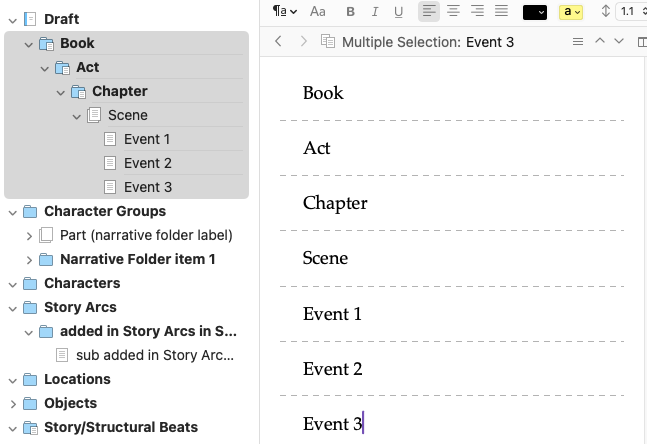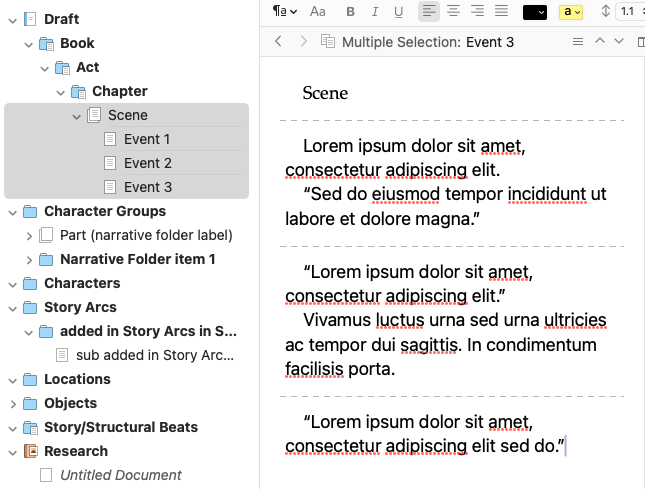Thank you for the video. First let me just say that the easiest way to understand Narrative vs Timeline is that Timeline is all the events in your story, even the ones that are not on-page, and Narrative is just what is in the manuscript in the order it appears there.
Also, one thing that is not clear with the documentation is that a scene in often made up of multiple events, and you have to break your scenes into sub-scenes in Scrivener in order for this to work. Most writers, I don’t think, use sub-scenes in Scrivener. I actually looked at the Orient Express sample and confirmed that they used multiple events and thus Narrative “scenes” (actually sub-scenes) for what is one scene (and often one scene per chapter) in the manuscript itself.
This is how most writers work:

This is how AT forces them to work if they want to track multiple events in one “scene”:

They would have to work in the Scene in Scrivener by selecting it and the 3 event sub-scenes in order for those 3 events to sync properly with the Timeline view.

I don’t know many writers who only work one event in each scene. One big event, maybe, but I don’t think that’s clear in the documentation. After years at this I had to dig into the Orient Express manuscript to see what they were actually doing. This is why I think it’s so confusing.
Anyway…
I keep going back and forth on using AT because it doesn’t quite do what I need it to do. The Narrative view is my favorite because of the stacking cards and it’s the number one reason I come back to AT. I find it a better brainstorming tool than the Mindmap which I do not like at all (it’s clunky; sorry). And by Narrative workflow, I mean that I like to start with the characters’ individual storylines and not really worry about how it will fit in the timeline or the “outline” of the finished novel. Not at this stage.
So for example, Maeve’s storyline would be one Narrative folder with multiple sub-documents in it as I drop in the things that happen to Maeve. Sometimes, like in single viewpoint novels, Maeve’s storyline may not appear at all in the manuscript since she’s not the PoV, Talia is. But I need to know what’s happening to and with Maeve, even if the reader doesn’t see those things on-page. The reason this planning has to take place in the Narrative, not the Timeline (at least for me) is that I can’t seem to think in a Gantt chart, but a board with cards independent of actual dates/days, works.
Then I will create more Narrative folders, one for each storyline/character, and move them around until I get a plot (the actual sequence of events). A lot of what is on these cards will not be on-page even in a multiple viewpoint novel. Despite having multiple storylines set up as “Narrative Folders” this is still not an outline as each chapter is actually just a story arc. The Outline proper comes in later as I merge the events happening to the characters into a 4-Act structure which is the end product, not how I start.
I think there’s a lot of assumption in the underlying way that AT works that we start with a story that’s already been structured (laid out in narrative or chronological order) . When you already have a book that’s been written (like Orient Express) and you break that down this makes sense. But when you don’t have a complete book that’s already laid out, that has a lot of stuff that may not make it on-page, then the workflow is quite different. Even in the Orient Express example, the actual chapters contained only one scene (no scene dividers) with multiple events that in AT are represented as separate “scenes” in order to make them work with the events on the Timeline.
I hope that what I’ve said makes sense.
I’m off to try working with Scrivener in the sub-scene format to see if I can make it work, but it’ll be a major adjustment. I’ll have to remember to select all the sub-scenes (events) that make up the actual scene. If I forget and accidentally click only in the “Scene” or forget to select the sub-scenes (events) then it’ll be a major issue.
If anyone has any suggestions or alternatives, or I’m misunderstanding/mis-working something I’m all ears. But I don’t see how else to do this since all of my actual scenes (as in Act–>Chapter–>Scene) are made up of multiple events.



















